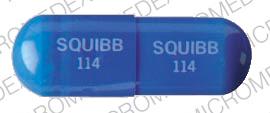Velosef Dosage
Generic name: Cephradine
Dosage form: capsule, suspension
Drug class: First generation cephalosporins
Medically reviewed by Drugs.com. Last updated on Oct 14, 2024.
Adults: For respiratory tract infections (other than lobar pneumonia) and skin and skin structure infections, the usual dose is 250 mg every 6 hours or 500 mg every 12 hours.
For lobar pneumonia, the usual dose is 500 mg every 6 hours or 1 g every 12 hours.
For uncomplicated urinary tract infections, the usual dose is 500 mg every 12 hours. In more serious urinary tract infections, including prostatitis, 500 mg every 6 hours or 1 g every 12 hours may be administered.
Larger doses (up to 1 g every 6 hours) may be given for severe or chronic infections.
Children: No adequate information is available on the efficacy of b.i.d. regimens in children under nine months of age. The usual dose in children over nine months of age is 25 to 50 mg/kg/day administered in equally divided doses every 6 or 12 hours. For otitis media due to H. influenzae, doses are from 75 to 100 mg/kg/day administered in equally divided doses every 6 or 12 hours, but should not exceed 4 g per day. Dosage for children should not exceed dosage recommended for adults.
All patients, regardless of age and weight: Larger doses (up to 1 g q.i.d.) may be given for severe or chronic infections.
As with antibiotic therapy in general, treatment should be continued for a minimum of 48 to 72 hours after the patient becomes asymptomatic or evidence of bacterial eradication has been obtained. In infections caused by group A beta-hemolytic streptococci, a minimum of 10 days of treatment is recommended to guard against the risk of rheumatic fever or glomerulonephritis. In the treatment of chronic urinary tract infection, frequent bacteriologic and clinical appraisal is necessary during therapy and may be necessary for several months afterwards. Persistent infections may require treatment for several weeks. Prolonged intensive therapy is recommended for prostatitis. Doses smaller than those indicated are not recommended.
Patients With Impaired Renal Function
Not on Dialysis: The following initial dosage schedule is suggested as a guideline based on creatinine clearance. Further modification in the dosage schedule may be required because of individual variations in absorption.
| Creatine Clearance |
Dose | Time Interval |
|---|---|---|
| > 20 mL/min | 500 mg | 6 hours |
| 5–20 mL/min | 250 mg | 6 hours |
| < 50 mL/min | 250 mg | 12 hours |
More about Velosef (cephradine)
- Check interactions
- Compare alternatives
- Drug images
- Side effects
- During pregnancy
- Drug class: first generation cephalosporins
- Breastfeeding
Professional resources
Related treatment guides
See also:
Further information
Always consult your healthcare provider to ensure the information displayed on this page applies to your personal circumstances.


